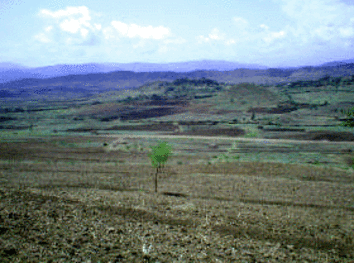What are the features of Integrated Watershed Management?
Earth benches in the watershed of Dana dam, Ethiopia. Earth benches are important soil and water conservation measures implemented often in IWM
Image Credit: Schütt, B. and Thiemann, St. 2001.
Basic features of the Integrated Watershed Management approach are:
- IWM is a holistic and integrated approach; i.e., the watershed is understood as an ecological system which can only survive as a unit. Thus, an understanding of all aspects of the watershed is essential in IWM:
- the individual components of the watershed (e.g., water resources, water user);
- the relationships between the characteristic form (e.g., slope, bedrock)
- the process factors (e.g., average precipitation intensity (Förch and Schütt 2004 b) (see interactions of geospheres).
Management of vital resources available in the watershed is to be carried out collectively and simultaneously to improve the living conditions of the local population (Tidemann 1996). Watershed-based planning aims to balance environmental goals with socio-economic and political goals within the watershed considered (Butler 2003).
- Its goals should comply with sustainability and environmental appropriateness (Förch et al. 2005; Förch und Schütt 2004 b).
- The planning process consists of comprehensive rational, transactive and adaptive planning modes (Butler 2003). The planning cycle is described in detail in the last chapter.
- IWM is a process of rational decision making in successive steps. Systematically the available management options are compared, and a Watershed Management plan is developed that is mainly a rural development concept (Heathcote 1998; Tidemann 1996).
- A central feature of IWM is the involvement of local people including their traditional knowledge and practices, which are to be combined with modern knowledge and techniques.
- Also, the cooperation between stakeholders, governmental departments (different sectoral departments, across jurisdictions and between the administrative levels), non-governmental organisations, industrial companies, etc., is essential. In this sense, the watershed planning process is a consensus-building process rather than an unidimensional scientific exercise (Heathcote 1998).
IWM is a flexible process that has to be adapted to the unique characteristics of distinctive watersheds and to changing conditions within individual watersheds (Heathcote 1998, 13).
Integrated Watershed Management measures are implemented by technical cooperation schemes at the level of projects or programmes. Nowadays it has been increasingly accepted as a measure in regional and inter-regional programmes and has become an integral part of development co-operation (Förch and Schütt 2004 b). It can especially be a reasonable approach to transboundary watershed management, e.g., riparian states of the Nile or of the Flöha River (SE Germany) that is topic in the test questions of this module.
'Which processes influences IWM' is explained on the following web page.

